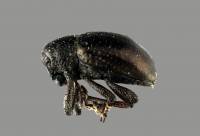Go to Encyclopedia of Life...
T. nigrum n. sp. - Form rather robust; body deep black throughout, moderately shining, scarcely metallic; tibiae dark fuscous. Head moderately convex, rather coarsely and feebly punctate, very sparsely so in the middle, more densely at the sides; rostrum very robust, anterior surface broadly impressed at the base, coarsely and longitudinally rugulose or furrowed, entire surface minutely granulose. Prothorax just perceptibly wider than long; sides just visibly divergent from the basal angles for two-fifths the length anteriorly, then rather suddenly and strongly constricted; very evenly and strongly arcuate anteriorly when viewed vertically, base very broadly and feebly arcuate; Hanks perpendicular, strongly swollen just over the anterior coxae, edge sinuate anteriorly, emargiuate for the coxae at the sides: disk of pronotum very sparsely punctate dorsally, where the punc- tures are round, small, impressed, and much finer anteriorly than toward the base; on the flanks the punctures are very irregularly distributed, much coarser, deeper, and generally closer; surface minutely granulose, feebly shining. Scutellum longer than wide, convex, angulate behind. Elytra at the humeri slightly more than one-third wider than the contiguous pronotum; sides parallel and very feebly arcuate for one-half the length, then gradually convergent; disk acutely rounded behind, very convex, scarcely more than one-lialf longer than wide, slightly more than twice as long as the pronotum; punctures large, deeply impressed, round, arranged in rows, distances of the punctures in the sutural rows much less than in the others: flanks inflexed; edges not bordered, nearly straight laterally, acute; viewed from beneath, the edges are very broadly cusped, cusp broadly rounded and placed at the sides of the third ventral segment. Under surface of abdomen sparsely punctate, slightly more densely so on the last segment, first two segments together slightly longer than the last three; metasternum very coarsely, deeply, and rather sparsely punctate, very coarsely granulose. Length 3.8 mm. Northern Illinois. This species differs from aereum and baridum in facies. One of the numerous structural differences is shown in figs. 10, 11, and 12, plate I., which represent the relations existing between the meso- sternal and metasternal episterna, and the mesosternal epimeron in the three species respectively. It is seen that, while the mesosternal episternum comes very far from attaining the metasternum in cereum it actually borders it for a short distance in the present species.












